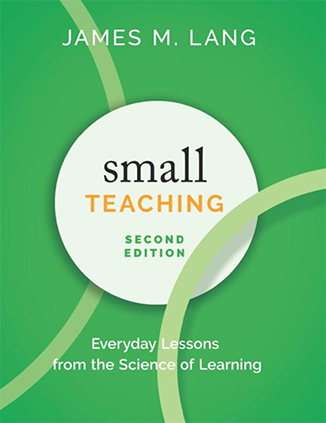Small Teaching
By Katie Pierson, Assistant Director of Engaged Learning and Strategic Initiatives
It can be tempting to discover an exciting new teaching approach—or realize your current approach is not working—and want to completely redesign your course. The reality is, unless you’re developing a course for the first time, we rarely have time to do an overhaul on an existing course. James Lang knows that temptation, and like the rest of us, he rarely finds the time to make radical changes to his courses. Instead, he makes small tweaks to his course design or teaching approach, which he shares with readers in the revised and updated version of his Small Teaching: Everyday Lessons from the Science of Learning (2021).
Small Teaching is a practical guide for educators looking to improve their teaching methods and increase student engagement using evidence-based and teacher tested strategies. Lang sums up his approach by saying that small teaching “seeks to spark positive change in higher education through small but powerful modifications to our course design and teaching practices. Small teaching as a fully developed strategy draws from the deep well of research on learning and higher education to create a deliberate, structured, and incremental approach to changing our courses for the better” (5). Throughout the book, Lang guides readers through an overview of the latest research on how students learn while offering straightforward strategies articulating how instructors can put the research into practice in a variety of disciplinary and classroom contexts.
At the heart of the recipe for creating deep and lasting learning experiences is the science of metacognition, which involves an awareness or analysis of our own thinking and learning process (Merriam-Webster). Lang structures the book around six key ingredients for metacognition:
- Prediction
- Retrieval
- Interleaving
- Connection
- Practice
- Explanation
He ties these chapters together with two final chapters on fostering belonging in the classroom and motivating students.
While figuring out how to incorporate these ingredients into your teaching might seem daunting, Lang offers easily actionable strategies such as, brief activities that can be immediately integrated into a class session, one time course interventions, or 3) small modifications to the course’s overall design or an instructor’s approach. Small Teaching is a great resource for any instructors interested in Course Design & Delivery, Assessment, or DEIJ.
How can you start “Small Teaching”?
- Prediction: Open class by asking students a question or two to frame the day’s objective and shift students’ attention away from life’s distractions.
- Connection: Conclude class by returning to those initial questions and close the feedback loop by having students reflect on how their responses might have changed.
- Retrieval: Start class with students recalling—either in writing or orally—the content covered in previous class sessions. When doing this activity orally, be sure to provide students with time to reflect.
- Explanation: During class, pause mid-lecture and pose a question about the content you just covered. Ask students to answer the question on their own, then have them explain their response and reasoning to a peer. This will help students practice explaining the information and alert them to places they need more practice.
